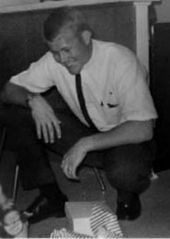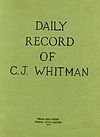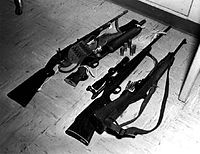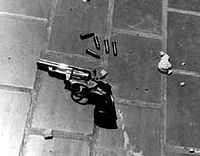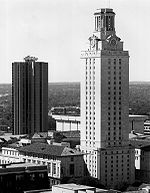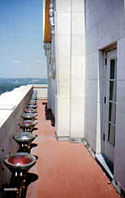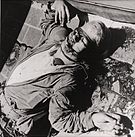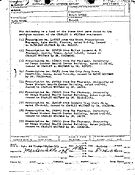- Charles Whitman
-
Charles Whitman 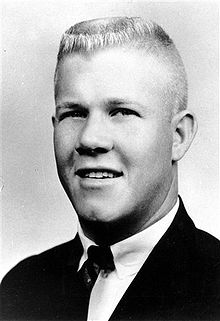
Born Charles Joseph Whitman
June 24, 1941
Lake Worth, Florida, U.S.Died August 1, 1966 (aged 25)
Austin, Texas, U.S.Cause of death Shot by police Nationality American Education University of Texas Engineering student Charles Joseph Whitman (June 24, 1941 – August 1, 1966) was a student at the University of Texas at Austin and a former Marine who killed 16 people and wounded 32 others during a shooting rampage on and around the university's campus on August 1, 1966.
Whitman killed three of his victims inside the university's tower, and 10 others from the 28th floor observation deck[1] of the University's 307-foot (94 m) administrative building; one, Karen Griffith, died a week after the shooting from her wounds.
The tower massacre happened shortly after Whitman murdered his wife and mother at their homes. He was shot and killed by Austin Police Officer Houston McCoy,[2][3][4][5] assisted by Austin Police Officer Ramiro Martinez.
Charles Whitman grew up in an upper-middle class family headed by a father who owned a successful plumbing contract business in Lake Worth, Florida. Whitman excelled academically and was well liked by his peers and neighbors. There were underlying dysfunctional issues within the family that escalated in 1966, when his mother left his father and moved to Texas. The elder Whitman was an authoritarian who provided for his family, but demanded near perfection from all of them. He was also known to become physically and emotionally abusive.
Whitman's frustrations with his dysfunctional family were complicated by abuse of amphetamines and health issues including headaches that he reported in one of his final notes as "tremendous."[6] A glioblastoma, which is a highly aggressive brain tumor, was discovered during autopsy; experts on the "Connally Commission" concluded it may have played a role in his actions. He was also affected by a court martial as a United States Marine, failings as a student at the University of Texas, ambitious personal expectations and psychotic features he expressed in his typewritten note left at 906 Jewell Street, Austin, Texas, dated both July 31, 1966 and later by hand "3 A.M., both dead August 1, 1966".
Several months prior to the shootings, he was summoned to Lake Worth, Florida to pick up his mother who was filing for divorce from his father. The stress caused by the break-up of the family became a dominant discussion between Whitman and a psychiatrist at the University of Texas Health Center on March 29, 1966.
Early life
Whitman's father, Charles Adolph Whitman, was raised at the Bethesda School For Boys in Savannah, Georgia. He met his wife, Margaret, in Savannah where they were married. She was a devout Roman Catholic while his religious views were unformed. They eventually moved to Lake Worth, Florida, where he opened a sewage plumbing business and purchased a home on South L Street in Lake Worth. Three sons were born to the Whitmans: Charles, Patrick, and John.
The Whitman children were raised in Lake Worth and attended St. Ann's High School in West Palm Beach. Charles was an extremely intelligent child, scoring 138 on an IQ test at age six.[7] He took five years of piano lessons[8] and was a pitcher on his high school baseball team.[7]
Whitman's childhood neighbors reported that Whitman had a fascination with firearms from a young age.[9] Whitman's father had an extensive firearm collection and taught all of his sons how to shoot, clean and maintain weapons. Charles had been exposed to guns as a young child, and never had any recorded incident of misuse or abuse of firearms.
All three Whitman children served as altar boys at Sacred Heart Roman Catholic Church,[10] and Whitman chose the Confirmation name Joseph for himself.[11] As a 12-year-old, he was among the youngest in history to achieve Eagle Scout and the first in Lake Worth to do so at that age.[12][13] When Whitman was 14 and still serving as an altar boy, his Scout leader, Joseph Leduc, completed seminary and served as the priest of Sacred Heart for one month. Leduc, later a confidant of Whitman, was a family friend who had accompanied Whitman and his father on several hunting trips. At the age of 16, Whitman underwent a routine appendectomy and was hospitalized following a motorcycle accident.[14]
Against his father's wishes, Whitman enlisted in the United States Marine Corps on July 6, 1959. He explained to Fr. Leduc that he had come home drunk several weeks earlier and his father had hit him repeatedly and pushed him into the family's swimming pool where he nearly drowned. While Whitman was aboard a train headed towards Marine Corps Recruit Depot Parris Island, his father telephoned "some branch of Federal Government" in an attempt to have his son's enlistment canceled.[10]
Adult life and family issues
Whitman entered the mechanical engineering program at the University of Texas on September 15, 1961, through a USMC scholarship. His hobbies at this point included karate, scuba diving, and hunting.[15] This last hobby got him into trouble at the University when he was involved in an incident in which he shot a deer, dragged it to his dormitory, and skinned it in his shower.[10] As a result of both this incident and sub-standard grades, Whitman's scholarship was withdrawn in 1963.[16]
In August 1962, Whitman married Kathleen Frances Leissner, another University of Texas student, in a wedding that was held in Leissner's hometown of Needville, Texas, and presided over by Fr. Leduc. The following year, he returned to active duty at Marine Corps Base Camp Lejeune, North Carolina, where he was both promoted to Lance Corporal and involved in an accident in which his Jeep rolled over an embankment. After rescuing a fellow Marine, Whitman was hospitalized for four days.[14] In November 1962, Whitman was court-martialed for gambling, possessing a personal firearm on base, and threatening another Marine over a $30 loan for which Whitman demanded $15 interest. He was sentenced to 30 days of confinement and 90 days of hard labor and was demoted to the rank of Private.[17]
In December 1964, Whitman was honorably discharged from the Marines and returned to the University of Texas, this time enrolling in the architectural engineering program. Whitman was working as a bill collector for Standard Finance Company and later as a bank teller at Austin National Bank. In January 1965, he had taken a temporary job with Central Freight Lines and worked as a traffic surveyor for the Texas Highway Department. He also volunteered as a Scoutmaster for Austin Scout Troop 5 while Kathy worked as a biology teacher at Lanier High School.
In May 1966, Whitman's mother announced she was filing for a divorce and contacted Charles after several altercations with his father. Whitman drove to Florida to help his mother move to Austin, where she found work in a cafeteria. The move prompted his youngest brother, John, to leave Lake Worth as well, but his brother Patrick decided to continue living with their father and working for him at his plumbing supply business. Shortly after he moved to Austin, John was arrested for throwing a rock through a window but released after paying a $25 fine.[7]
Whitman's father began to telephone Whitman several times a week, pleading with him to convince his mother to return to Lake Worth, but he refused.
Whitman's journal
Within the journal are entries covering Whitman's everyday life in the Marine Corps and his interactions with Kathy and other family members. He also writes about his court martial and disrespect for the Marine Corps, especially the inefficiencies he perceived within it. In writing about Kathy, he praises her often, talks about how much he loves her and, while separated from her during Marine Corps service and disgrace, how much he misses her. He also chronicles his attempts and plans to free himself from financial dependence on his father.
John and Fran Morgan, close friends of Whitman's, later told the Texas Department of Public Safety that he had confided in them that he had struck Kathy on three occasions.[18] He laments in his journal that he has hit Kathy and resolves to be a good husband, not an abusive one like his father.
On the eve of the shootings at the University Tower, Whitman confirmed some of his feelings for Kathy in addition to previous journal entries. They are written in the past tense, suggesting he had already killed Kathy and his mother when he wrote them.
Prelude to the tower shootings
The day before the shootings, Whitman purchased binoculars and a knife from Davis' Hardware, as well as Spam from a 7-Eleven store. He then picked up his wife from her summer job as a Bell operator, before meeting his mother for lunch at her job at the Wyatt Cafeteria near the campus.
Around 4:00 p.m., they went to visit friends John and Fran Morgan, who lived in the same neighborhood. They left at approximately 5:50 so that Kathy Whitman could leave for her 6:00–10:00 p.m. shift that night. At 6:45, Whitman began typing his suicide note, a portion of which read:
- I do not quite understand what it is that compels me to type this letter. Perhaps it is to leave some vague reason for the actions I have recently performed. I do not really understand myself these days. I am supposed to be an average reasonable and intelligent young man. However, lately (I cannot recall when it started) I have been a victim of many unusual and irrational thoughts.[19]
The note explained that he had decided to murder both his mother and wife, but made no mention of the coming attacks at the university. Expressing uncertainty about his actual reasons, he nevertheless observed that he felt he wanted to relieve them from the suffering of this world.
Just after midnight, he killed his mother Margaret. The exact method is disputed, but it seemed he had rendered her unconscious before stabbing her in the heart. He left a handwritten note beside her body, which read in part:
- To Whom It May Concern: I have just taken my mother's life. I am very upset over having done it. However, I feel that if there is a heaven she is definitely there now...I am truly sorry...Let there be no doubt in your mind that I loved this woman with all my heart.[20]
Whitman returned to his home at 906 Jewell Street and stabbed his wife Kathy three times in the heart as she slept, returning to the typewritten note he had begun earlier, finishing it by hand, and saying:
- I imagine it appears that I brutally killed both of my loved ones. I was only trying to do a quick thorough job...If my life insurance policy is valid please pay off my debts...donate the rest anonymously to a mental health foundation. Maybe research can prevent further tragedies of this type.[19]
He also requested that an autopsy be done after his death, to determine if there had been anything to explain his actions and increasing headaches, and wrote notes to each of his brothers and his father and left instructions in the apartment that the two canisters of film he left on the table should be developed, and the puppy Schocie should be given to Kathy's parents.[19]
At 5:45 a.m. on Monday, August 1, 1966, Whitman phoned Kathy's supervisor at Bell to explain that she was sick and could not make her shift that day. He made a similar phone call to Margaret's workplace about five hours later.
Whitman arrives at the tower
Whitman had rented a hand truck from Austin Rental Company and cashed $250 of worthless checks at the bank before going to Davis' Hardware and purchasing an M1 carbine, explaining that he wanted to go hunting for wild hogs. He also went to Sears and purchased a shotgun and a green rifle case. After sawing off the shotgun barrel while chatting with postman Chester Arrington, Whitman packed it together with a Remington 700 6mm bolt-action hunting rifle with a 4x Leupold Scope, an M1 carbine, a Remington .35 caliber pump rifle and various other equipment stowed in a wooden crate and his Marine footlocker. He also had a .357 Magnum revolver, 9mm German Luger, and another small caliber pistol on his person. Before heading to the tower, he put khaki coveralls on over his shirt and jeans. Once in the tower, he also donned a white sweatband.[21]
Pushing the rented dolly carrying his equipment, Whitman met security guard Jack Rodman and obtained a parking pass, claiming he had a delivery to make and showing Rodman a card identifying him as a research assistant for the school. He entered the Main Building shortly after 11:30 a.m., where he struggled with the elevator until employee Vera Palmer informed him that it had not been powered and turned it on for him. He thanked her and took the elevator to the 27th floor of the tower, just one floor beneath the clock face.[8]
Whitman then lugged the dolly up one long flight of stairs to the hallway that led to a dog-legged stairway that went up to the rooms within the observation deck area. Edna Townsley was the receptionist on duty and observed Whitman's trunk and asked if he had his University work identification. He then knocked her unconscious with the butt of his rifle and dragged her body behind a couch; she later died from her injuries at Seton Hospital. Moments later, Cheryl Botts and Don Walden, a young couple who had been sightseeing on the deck, returned to the receptionist area and encountered Whitman, who was holding a rifle in each hand. Botts later claimed that she believed that the large red stain on the floor was varnish, and that Whitman was there to shoot pigeons. Whitman and the young couple exchanged hellos and the couple left for the elevators. When they were gone, Whitman barricaded the stairway.
Shortly afterward, two families, the Gabours and Lamports, were on their way up the stairs when they encountered the barricade. Michael Gabour was attempting to look beyond the barricade when Whitman fired the sawed-off shotgun at him, hitting him in the left neck and shoulder region, sending him over the staircase railing onto other family members. Whitman fired the sawed-off shotgun two more times through grates on the stairway into the families as they tried to run back down the stairs. Mark Gabour and his aunt Marguerite Lamport died instantly; Michael was partially disabled and his mother was permanently disabled.
Sniper fire commences
The first shots from the tower's outer deck came at approximately 11:48 a.m. A history professor was the first to phone the Austin Police Department, after seeing several students shot in the South Mall gathering center; many others had dismissed the rifle reports, not realizing there was gunfire. Eventually, the shootings caused panic as news spread and, after the situation was understood, all active police officers in Austin were ordered to the campus. Other off-duty officers, Travis County Sheriff's deputies, and Texas Department of Public Safety troopers also converged on the area to assist.
Around 20 minutes later, once Whitman began facing return fire from the authorities and armed civilians who had brought out their personal firearms to assist police, he used the waterspouts on each side of the tower as gun ports, allowing him to continue shooting largely protected from the gunfire below but also greatly limiting his range of targets. Ramiro Martinez, an officer who participated in stopping Whitman's rampage, later stated that the civilian shooters should be credited as they made it difficult for him to take careful aim.[22] Police lieutenant Marion Lee reported from a small airplane that there was only a single sniper firing from the observation deck. The airplane circled the tower while Lee tried to shoot Whitman, but turbulence made it difficult for him to get a clear shot. The airplane, piloted by Jim Boutwell, was hit by Whitman's rifle fire but continued to circle the tower from a safe distance until the end of the incident.
Whitman's choice of victims was indiscriminate; most of them were shot on Guadalupe Street, a major commercial and business district across from the west side of the campus. Efforts to reach the wounded included an armored car and ambulances run by local funeral homes. Ambulance driver Morris Hohmann was responding to victims on West 23rd Street when he was shot in the leg, severing an artery. Another ambulance driver quickly attended to Hohmann, who was then taken about ten blocks south of UT to Brackenridge Hospital, which had the only local emergency room. The Brackenridge administrator declared an emergency, and medical staff raced there to reinforce the on-duty shifts. Following the shootings, volunteers donated blood at both Brackenridge and the Travis County Blood Bank.
Whitman's death
Austin Police Department (APD) Officers Ramiro Martinez, Houston McCoy and Jerry Day, plus civilian Allen Crum, were the first to reach the tower's observation deck, stepping outside the south door at 1:24 p.m. Martinez, closely followed by McCoy, formed one team and proceeded north on the east deck. Day, followed by Crum, formed a second team and proceeded west on the south deck, with Whitman believed to be between the two teams. Several feet before reaching the southwest corner, Crum accidentally discharged a shot from his borrowed rifle. At the same time, Martinez jumped around the corner into the northeast area and rapidly fired all six rounds from his .38 police revolver at Whitman. As Martinez was firing, McCoy jumped to the right of him and fired two fatal shots of 00-buckshot with his 12-gauge shotgun into the head, neck, and left side of Whitman, who was sitting with his back toward the north wall in the northwest corner area 50 feet away. Whitman, who appeared to be unaware of the presence of Martinez and McCoy, was partially shielded by the deck tower lights and in a position to defend assaults from either corner.
After firing six rounds, Martinez threw his empty revolver onto the deck and grabbed McCoy's shotgun, running to Whitman's prone body and firing point blank into his upper left arm. Martinez then threw the shotgun on the deck and hurriedly left the scene repeatedly shouting, "I got him."
After tending to the wounded in the stairwell, APD Officers Milton Shoquist, Harold Moe and George Shepard made their way up the stairs to join APD Officer Phillip Conner and Texas Department of Public Safety Agent W.A. Cowan, arriving on the 28th floor as Martinez, McCoy, Day and Crum were outside on the observation deck. Moe, with a hand-held radio, heard Martinez as he ran past shouting "I got him," and relayed his words to the APD radio dispatcher.[3]
Houston McCoy appeared before the Travis County Grand Jury on August 5, 1966 and received a justifiable homicide verdict for the death of Whitman.
Autopsy and burial
At the Cook Funeral Home the next day, an autopsy was performed as requested in Whitman's suicide note and approved by Whitman's father, Charles Adolf Whitman, and performed by Dr. Chenar. A brain tumor was found and initially reported as an astrocytoma brain tumor,[23] although results from the subsequent Governor's report investigation revealed the tumor was a glioblastoma that, according to the report, "conceivably could have contributed to his inability to control his emotions and actions".[14]
There was a joint funeral service for Whitman and his mother officiated by Fr. Tom Anglim at his home parish of Sacred Heart in Lake Worth. Due to his status as a veteran Marine, Whitman had a casket draped with an American flag for his burial in Section 16 of the Hillcrest Memorial Park in West Palm Beach, Florida, next to his mother and brother John.[citation needed]
Casualties
Killed
- Margaret Whitman, 43, killed in her apartment
- Kathy Whitman, 23, killed while she slept
- Edna Townsley, 47, tower observation deck receptionist
- Marguerite Lamport, killed by shotgun on tower stairs leading to the observation room inside the deck
- Mark Gabour, 16, killed by shotgun on tower stairs leading to the observation room inside the deck
- Thomas Eckman, 19, shoulder wound, kneeling over Claire Wilson, died on the mall
- Robert Boyer, 33, back wound, visiting physics professor
- Thomas Ashton, 22, chest wound, Peace Corps trainee
- Thomas Karr, 24, spine wound
- Billy Speed, 22, police officer, hit in the shoulder and traveled into the chest
- Harry Walchuk, 39, doctoral student and father of six
- Paul Sonntag, 18, shot through the mouth while hiding behind construction barriers
- Claudia Rutt, age 18, killed helping fiancé Sonntag
- Roy Schmidt, 29, electrician shot outside his truck near the Littlefield Fountain
- Karen Griffith, 17, chest wound, died after a week in the hospital
- Unborn child, fatally injured when Claire Wilson was shot in her upper rear hip, exiting the abdomen
Died after 30 years
- Gunby, David[24]
Declining health and the University of Texas Health Center
Whitman had visited several University doctors who prescribed various medications, although most of the specific medications are unknown. According to a list compiled by investigating officers, Whitman had seen at least five doctors between the fall and winter of 1965, before a visit with a psychiatrist who gave no prescription. He was prescribed Valium by Dr. Jan Cochrum, who recommended he visit a campus psychiatrist. Maurice Dean Heatly, a staff psychiatrist at the University of Texas Health Center, met Whitman on March 29, 1966.[17] Whitman mentioned the visit with Heatly in his final suicide notes, saying that the visit was to "no avail".
Although Whitman had been prescribed drugs, and Whitman had a vial containing Dexedrine on his body after his death, the autopsy could not establish if he had consumed any drugs prior to the shooting. Whitman's bodily fluids had been removed and his body embalmed prior to the autopsy, so there was no urine to test for the amphetamines. It was revealed during the autopsy that Whitman had a glioblastoma tumor in the hypothalamus region of his brain. Forensic investigators theorized that this may have been pressed against the nearby amygdala, which can have an effect on fight/flight responses. This has led some neurologists to speculate that his medical condition was in some way responsible for the attacks, as well as his personal and social frames of reference.[25]
The University of Texas refuses to release the medical records and history of Whitman at the University of Texas citing legal and ethical issues.[26] The only record released was that of Dr. Heatly once it had become known to the press that Whitman had seen a psychiatrist at their facility.
Whitman's final note reflects: "I talked with a Doctor once for about two hours and tried to convey to him my fears that I felt come [sic, probably meant "some"] overwhelming violent impulses. After one visit, I never saw the Doctor again, and since then have been fighting my mental turmoil alone, and seemingly to no avail."[19]
Dr. Heatly's notes on the visit confirmed the visit with Whitman, reflecting his claim of hostilities: "This massive, muscular youth seemed to be oozing with hostility...that something seemed to be happening to him and that he didn't seem to be himself." Dr. Heatley also referenced an ominous statement that Whitman did not refer to in his letter, "He readily admits having overwhelming periods of hostility with a very minimum of provocation. Repeated inquiries attempting to analyze his exact experiences were not too successful with the exception of his vivid reference to 'thinking about going up on the tower with a deer rifle and start shooting people'."[27] Whitman never visited Dr. Heatly again.
Almost immediately, Governor John Connally commissioned a task force of professionals to examine the facts surrounding Whitman's actions and possible motives. The commission was composed of neurosurgeons, psychiatrists, psychologists and the University of Texas Health Center Director, Dr. White, as well as Dr. Maurice Heatley, the last known person to treat Whitman prior to the event. The Commission found that Dr. Chenar's initial autopsy was in error, that the glioblastoma tumor conceivably could have had an influence on his actions (pgs. 10-11), and that the vascular formation of veins around the area of the tumor may have been a congenital formation, suggesting that the tumor had been dormant and suddenly appeared due to the necrosis that surrounded the tumor.[14] This suggested that Whitman was predisposed to develop the tumor and die at an early age, whether he had gone on the rampage or not.[28] The study was done using Dr. Chenar's paraffin wax slide specimen of the tumor, stained specimens of Whitman's brain tissue and the remainder of the brain matter that was available.
The University of Texas and the Governor's report of August 8, 1966
During Whitman's command of the tower, the university became aware that the shooter might have been a student. Once the identity of Whitman was released, officials of the university did a search of Whitman's records and found that Whitman had been to the University Health Center on several occasions. On March 29, 1966, Whitman had a session with Dr. Maurice Heatley, an employee and psychiatrist at the University's Health Center in Austin. Whitman references the visit in his typewritten letter found at his residence at 906 Jewell Street, Austin, TX and dated July 31, 1966.
The University of Texas and the Commission's recommendations for aid to the injured
Upon completing all the information that the Commission had gathered, recommendations were made to aid the wounded and those affected by the events. Aid to survivors and the wounded were to include loans, University of Texas and the State of Texas agencies to temporarily assist those with medical and lingering mental issues and rehabilitation after the event. In respect to the recommendations made regarding the victims, they were never followed.[29]
According to Esquire magazine, "There is no monument, plaque, or notice on the University of Texas campus about that day and the killings. Every few years, the matter comes up, and every few years no one can decide what, if anything, to do."[30]
University of Texas "Memorial" Garden
In 2003, the University of Texas committed $200,000 and sought another $800,000 to redesign the "Memorial Garden" that was dedicated in recognition of the events on and around the campus on August 1, 1966. After years of neglecting to recognize the significance of the tragedy that day, by either public or private acknowledgment, the Memorial Garden was dedicated in 2006, forty years after the event, at an unknown cost and for minimal materials.[31] After years of planning and consulting, a bronze plaque, dedicated to all who were affected, was placed near the pond.[32]
After the shooting, the Tower observation deck was closed for two years, reopening in 1968. After several suicides, it was closed again in 1974 and remained closed until September 15, 1999. Access to the tower is now tightly controlled through guided tours that are scheduled by appointment only, during which metal detectors and other security measures are in place. Repaired scars from bullets are still visible on the limestone walls.
August 1, 2008 "Heroes Tower Building Dedication"
On the 42nd anniversary of the tragedy, the following names were added to a Precinct Building in Austin, Texas and dedicated to the principal heroes who helped stop Whitman on August 1, 1966. The below-mentioned names on the plaque represent the individuals who were within the tower and directly affected the outcome, although it was recognized that the list is incomplete.[3]
- Officer Billy Paul Speed, the only Austin police officer slain August 1, 1966.
- Officer Phillip Conner of Austin, ex-Army medic who administered first aid and covered the west window while officers went onto the observation deck.
- Officer Jerry Day of Universal City, who moved a wounded victim out of the line of fire and went to the top of the tower alone.
- Lt. Marion Lee, the gunner in the airplane piloted by Jim Boutwell.
- Officer Ramiro Martinez of New Braunfels, who made his way onto the tower deck and was the first to spot and shoot at Whitman.
- Officer Houston McCoy of Menard, who fired the fatal shots into Whitman.
- Officer Harold Moe of Marble Falls, who was instrumental in saving the lives of two gunshot victims and used the only portable two-way radio to notify police that the siege was over.
- Officer George Shepard, who was instrumental in saving the lives of two gunshot victims.
- Officer Milton Shoquist of Fair Oaks Ranch, who was instrumental in saving the lives of two gunshot victims.
- Department of Public Safety Agent W.A. "Dub" Cowan, who made his way to the top of the tower and was instrumental in setting up communications and removing people from harm's way on the 27th floor.
- Jim Boutwell, who volunteered his airplane and piloted it slowly above the tower to gather information and to help subdue the sniper.
- Allen Crum, first-floor supervisor of UT Co-op, who made his way atop the UT Tower and, with Agent Cowan’s weapon, assisted Officer Martinez and backed up Officer Day on the south side of the observation deck.
- Frank Holder, elevator mechanic for Otis Elevator Co., who led officers up the tower and assisted them in negotiating the stairs leading to the observation deck.
- William Wilcox, engineer for UT Physical Plant, who led officers through the underground tunnels to safely enter the tower building, assist the wounded and subdue the sniper.
References
- Notes
- Citations
- ^ "UT Tower Has Seen Fire." Utexas.edu. Retrieved: November 2, 2010.
- ^ "Casting off shadow of UT Tower shooting." "Austin American Statesman,"May 14, 2011. Retrieved: May 16, 2011.
- ^ a b c Flippin, Perry. "UT Tower Heroes to be Honored." SA Standard Times,August 6, 2007. Retrieved: November 2, 2010.
- ^ "Sixty years serving those who answer the calls.The Police Line. via Austin Police Association, Volume 1: 2009. Retrieved: August 1, 2010.
- ^ "Camp Sol Mayer-Houston McCoy." westtexasscoutinghistory.net, August 1, 2010. Retrieved: November 2, 2010.
- ^ Whitman, Charles. "Typewritten letter by Charles Whitman." cimedia.com, August 1, 1966. Retrieved: November 2, 2010.
- ^ a b c Cawthorne, Nigel. "Spree Killers". authorsonline.com. Retrieved: November 2, 2010.
- ^ a b Hicks, Jesse. "What Charlie Saw." deekmagzine.com, April 2006. Retrieved: November 2, 2010.
- ^ Krebs, Albin. "The Texas Killer: Former Florida Neighbors Recall a Nice Boy Who Liked Toy Guns." The New York Times, August 2, 1966. Retrieved: November 2, 2010.
- ^ a b c "Chaplain Leduc." cimedia.com. Retrieved: November 2, 2010.
- ^ "Deranged tower sniper rained death on UT campus." Houston Chronicle. Retrieved: November 2, 2010.
- ^ "Early Charlie." Charles Whitman: The Texas Tower Sniper, Crime Library, 2005. Retrieved: November 2, 2010.
- ^ Aiken, Tom. "Boom Boom... Out Go the Lights." Austin Chronicle. Retrieved: November 2, 2010.
- ^ a b c d "Deranged tower sniper rained death on UT campus." Houston Chronicle. Retrieved: November 2, 2010.
- ^ "The Madman in the Tower." TIME Magazine, August 12, 1966.
- ^ "Handbook of Texas Online." tshanonline.com. Retrieved: November 2, 2010.
- ^ a b MacLeod, Marlee. "Charles Whitman: The Texas Tower Sniper." Crime Library. Retrieved: November 2, 2010.
- ^ "John and Fran Morgan statement." The Whitman Archives via Austin American-Statesman. August 2, 1966.
- ^ a b c d Whitman, Charles. "Whitman Letter." The Whitman Archives. Austin American-Statesman. July 31, 1966.
- ^ Whitman, Charles. "Whitman Note Left with Mother's Body." The Whitman Archives via Austin American-Statesman, August 1, 1966.
- ^ "UT tower gunman put an end to honeymoon." The Paris News. Retrieved: November 2, 2010.
- ^ "Ray Martinez: They Call Me Ranger Ray." Morgan Printing. Retrieved: November 2, 2010.
- ^ "Autopsy Protocol." The Whitman Archives. Austin American-Statesman. August 2, 1966.
- ^ "Victim of UT Tower shooting dies after 30 Years: David Gunby dies." Texas History and Landmarks, November 7, 2001.
- ^ "Amygdala." brainmind.com. Retrieved: November 2, 2010.
- ^ "Exceptions to disclosure". Attorney General of Texas. Archived from the original on 2009-07-06. http://replay.waybackmachine.org/20090706001130/http://www.oag.state.tx.us/AG_Publications/txts/2004publicinfohb_2_02.shtml.
- ^ Heatly, Maurice. "Whitman Case Notes." The Whitman Archives. Austin American-Statesman. March 29, 1966.
- ^ "The Whitman Archive." statesman.com. Retrieved: November 2, 2010.
- ^ "Whitman findings." cimendia.com.Retrieved: November 2, 2010.
- ^ Bowden, Charles. "The Tower Tragedy." Esquire, February 1, 1999. Retrieved: November 2, 2010.
- ^ "University unveils redesign plans for Tower Garden Memorial." Utexas.edu. Retrieved: November 2, 2010.
- ^ "University Of Texas Tower Sniper Recalled." CBS, April 16, 2007. Retrieved: November 2, 2010.
- Bibliography
- Douglas, John and Mark Olshaker. The Anatomy of Motive. New York: Scribner, 1999. ISBN 0-7567-5292-2.
- Lavergne, Gary M. A Sniper in the Tower. Denton, Texas: University of North Texas Press, 1997. ISBN 1-57441-029-6.
- Levin, Jack and James Alan Fox. Mass Murder: America's Growing Menace. New York: Plenum Press, 1985. ISBN 0-306-41943-2.
- Martinez, Ramiro. They Call Me Ranger Ray: From the UT Tower Sniper to Corruption in South Texas. New Braunfels, Texas: Rio Bravo Publishing, 2005. ISBN 0-9760162-0-6.
- Tobias, Ronald. They Shoot to Kill: A Psycho-History of Criminal Sniping. Boulder, Colorado: Paladin Press, 1981. ISBN 0-87364-207-4.
External links
- Charles Whitman from the Handbook of Texas Online
- The Whitman Archives of the Austin Statesman
- Charles Whitman at Find a Grave
- Charles Whitman Research Guide from the Austin History Center
- Internet Movie Database link to The Deadly Tower, a 1975 made-for-TV movie based on the Whitman shootings; Kurt Russell portrayed sniper Charles Whitman
Categories:- 1941 births
- 1966 deaths
- 1966 in the United States
- People from Lake Worth, Florida
- History of Austin, Texas
- Criminal snipers
- American spree killers
- United States Marines
- University of Texas at Austin alumni
- University shootings in the United States
- Deaths by firearm in Texas
- People shot dead by law enforcement officers in the United States
- Massacres in the United States
- Murder in Texas
- Eagle Scouts
- Matricides
Wikimedia Foundation. 2010.

